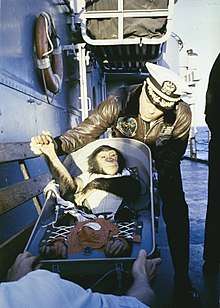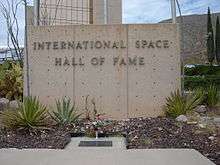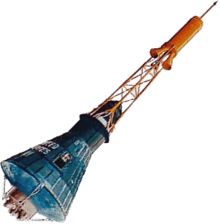Ham (chimpanzee)
Ham (1955 – January 19, 1983), also known as Ham the Chimp and Ham the Astrochimp, was a chimpanzee and the first hominid launched into space. On January 31, 1961, Ham flew a suborbital flight on the Mercury-Redstone 2 mission, part of the U.S. space program's Project Mercury.[1][2] Ham's name is an acronym for the laboratory that prepared him for his historic mission—the Holloman Aerospace Medical Center, located at Holloman Air Force Base in New Mexico, southwest of Alamogordo. His name was also in honor of the commander of Holloman Aeromedical Laboratory, Lieutenant Colonel Hamilton "Ham" Blackshear.[3][4]
.jpg) Ham in January 1961, before his flight into space | |
| Species | Common chimpanzee |
|---|---|
| Sex | Male |
| Born | 1955 French Cameroon |
| Died | January 19, 1983 (aged 25–26) North Carolina Zoo, North Carolina, U.S.A |
| Known for | First hominid in space |
Early life
Ham was born in 1957 in French Cameroon (now Cameroon),[5][6] captured by animal trappers and sent to Rare Bird Farm in Miami, Florida. He was purchased by the United States Air Force and brought to Holloman Air Force Base in 1959.[5]
There were originally 40 chimpanzee flight candidates at Holloman. After evaluation, the number of candidates was reduced to 18, then to six, including Ham.[7]:245–246 Officially, Ham was known as No. 65 before his flight,[8] and only renamed "Ham" upon his successful return to Earth. This was reportedly because officials did not want the bad press that would come from the death of a "named" chimpanzee if the mission were a failure.[9] Among his handlers, No. 65 had been known as "Chop Chop Chang".[10][9]:page 138
Training and mission

Beginning in July 1959, the two-year-old chimpanzee was trained under the direction of neuroscientist Joseph V. Brady at Holloman Air Force Base Aero Medical Field Laboratory to do simple, timed tasks in response to electric lights and sounds.[11] During his pre-flight training, Ham was taught to push a lever within five seconds of seeing a flashing blue light; failure to do so resulted in an application of a light electric shock to the soles of his feet, while a correct response earned him a banana pellet.[12]:243
What differentiates Ham's mission from all the other primate flights to this point is that he was not merely a passenger, and the results from his test flight led directly to the mission Alan Shepard made on May 5, 1961, aboard Freedom 7.[13]
On January 31, 1961, Ham was secured in a Project Mercury mission designated MR-2 and launched from Cape Canaveral, Florida, on a suborbital flight.[1][12]:314–315 Ham's vital signs and tasks were monitored by sensors and computers on Earth.[14] The capsule suffered a partial loss of pressure during the flight, but Ham's space suit prevented him from suffering any harm.[12]:315 Ham's lever-pushing performance in space was only a fraction of a second slower than on Earth, demonstrating that tasks could be performed in space.[12]:316 Ham's capsule splashed down in the Atlantic Ocean and was recovered by a rescue ship later that day.[12]:316 His only physical injury was a bruised nose.[14] His flight was 16 minutes and 39 seconds long.[15]
Later life

After the flight, Ham lived for 17 years in the National Zoo in Washington, D.C.,[7]:255–257 before joining a small group of captive chimps at North Carolina Zoo.[16]
After his death in 1983, Ham's body was turned over to the Armed Forces Institute of Pathology for necropsy. Following the necropsy, the plan was to have him stuffed and placed on display at the Smithsonian Institution, following Soviet precedent with pioneering space dogs Belka and Strelka. However, this plan was abandoned after a negative public reaction. Ham's remains, minus the skeleton, were buried at the International Space Hall of Fame in Alamogordo, New Mexico. Colonel John Stapp gave the eulogy at the memorial service.[17] The skeleton is held in the collection of the National Museum of Health and Medicine.[6]
Ham's backup, Minnie, was the only female chimpanzee trained for the Mercury program. After her role in the Mercury program ended, Minnie became part of an Air Force chimpanzee breeding program, producing nine offspring and helping to raise the offspring of several other members of the chimpanzee colony.[7]:258–259 She was the last surviving astro-chimpanzee and died at age 41 on March 14, 1998.[7]:259
In popular culture
- Tom Wolfe's 1979 book The Right Stuff depicts Ham's spaceflight,[18] as does the subsequent film adaptation.
- The 2001 film Race to Space was a fictionalized version of Ham's story; the chimpanzee in the movie is named "Mac".[19]
- In 2007, a French documentary made in association with Animal Planet, Ham—Astrochimp #65, tells the story of Ham as witnessed by Jeff, who took care of Ham until his departure from the Air Force base after the success of the mission. It is also known as Ham: A Chimp into Space / Ham, un chimpanzé dans l'espace.[20]
- A 2008 animated film, Space Chimps, was about sending chimpanzees to space. The main character and hero of the movie was named Ham III, the grandson of Ham.[21]
- In 2008, Bark Hide and Horn, a folk-rock band from Portland, Oregon, released a song titled "Ham the Astrochimp", detailing the journey of Ham from his perspective.[22]
- In the I Dream of Jeannie episode "Fly Me to the Moon" Larry Storch played an astrochimp named Sam who was accidentally turned into a human.[23]
See also
- Animals in space
- Enos, first chimpanzee to orbit the Earth
- Félicette, first cat in space
- Monkeys and apes in space
- Yuri Gagarin, first human in space, orbited in April 1961
- One Small Step: The Story of the Space Chimps, 2008 documentary
References
- "Chimp survives 420-mile ride into space". Lewiston Morning Tribune. Idaho. Associated Press. February 1, 1961. p. 1.
- "Chimp sent out on flight over Atlantic". The Bulletin. Bend, Oregon. UPI. January 31, 1961. p. 1.
- Swenson Jr., Loyd S.; Grimwood, James M.; Alexander, Charles C. (1989). "This New Ocean: A History of Project Mercury". NASA History Series. NASA Special Publication-4201. Retrieved November 10, 2017.
- Brown, Laura J. (November 13, 1997). "Obituary: NASA Medical director Hamilton 'Ham' Blackshear". Florida Today. Retrieved November 10, 2017.
- Gray, Tara (1998). "A Brief History of Animals in Space". National Aeronautics and Space Administration. Retrieved May 12, 2008.
- Nicholls, Henry (February 7, 2011). "Cameroon's Gagarin: The Afterlife of Ham the Astrochimp".
- Burgess, Colin; Dubbs, Chris (January 24, 2007). Animals in Space: From Research Rockets to the Space Shuttle. Springer-Praxis Books in Space Exploration. Springer. ISBN 978-0-387-36053-9. OCLC 77256557.
- Hanser, Kathleen (November 10, 2015). "Mercury Primate Capsule and Ham the Astrochimp". airandspace.si.edu. Smithsonian National Air & Space Museum. Archived from the original on May 20, 2018. Retrieved May 20, 2018.
- Haraway, Donna (1989). Primate Visions: Gender, Race, and Nature in the World of Modern Science. New York: Routledge.
- "Chop Chop Chang Commemorative Patch (HAM the Astrochimp)". Retrorocket Emblems. Archived from the original on May 20, 2018. Retrieved May 20, 2018.
- House, George (April–June 1991). "Project Mercury's First Passengers". Spacelog. 8 (2): 4–5. ISSN 1072-8171. OCLC 18058232.
- Swenson Jr., Loyd S.; Grimwood, James M.; Alexander, Charles C. (1966). This New Ocean: A History of Project Mercury. NASA History Series. National Aeronautics and Space Administration. OCLC 00569889. Retrieved May 11, 2008.
- Burgess, Colin (2014). "The Mercury flight of chimpanzee Ham" (PDF). Freedom 7. Springer. pp. 58–59. doi:10.1007/978-3-319-01156-1_2. ISBN 978-3-319-01155-4.
- Zackowitz, Margaret G. (October 2007). "The Primate Directive". National Geographic. Archived from the original on November 12, 2007. Retrieved April 30, 2008.
- "NASA Project Mercury Mission MR-2". National Aeronautics and Space Administration. Retrieved May 11, 2008.
- "Ham the astrochimp: hero or victim?". The Guardian. December 16, 2013.
- Roach, Mary (2010). Packing for Mars: The Curious Science of Life in the Void. Norton. pp. 160–163. ISBN 978-0393068474.
- Wolfe, Tom (March 4, 2008). The Right Stuff. Farrar, Straus and Giroux. p. 178. ISBN 9781429961325.
- Foundas, Scott (March 14, 2002). "Race to Space". Variety. Retrieved January 30, 2019.
- Kerviel, Sylvie (July 13, 2007). "Ham, un chimpanzé dans l'espace". Le Monde (in French). Retrieved January 30, 2019.
- Space Chimps at AllMovie
- For Melville, With Love, by Ezra Ace Caraeff, August 14, 2008, Portland Mercury
- Lathers, Marie (May 3, 2012). Space Oddities: Women and Outer Space in Popular Film and Culture, 1960–2000. A&C Black. p. 128. ISBN 9781441172051.
Further reading
- Farbman, Melinda; Gaillard, Frye (June 2000) [2000]. Spacechimp: NASA's Ape in Space. Countdown to Space. Berkeley Heights, New Jersey: Enslow Publishers. ISBN 978-0-7660-1478-7. OCLC 42080118. Brief biography of Ham, aimed at children ages 9–12.
- Rosenstein, Andrew (July 2008). Flyboy: The All-True Adventures of a NASA Space Chimp. Windham, Maine: Yellow Crane Press. ISBN 978-0-9758825-2-8. A novel about Ham and his trainer.
- Burgess, Colin; Dubbs, Chris. Animals in Space: From Research Rockets to the Space Shuttle. Springer-Praxis Books. ISBN 978-0-387-36053-9. Book covering the life and flight of Ham, plus other space animals.
External links
| Wikimedia Commons has media related to Ham the Chimp. |
- Pictures from the NASA Life Sciences Data Archive
- Who2 profile: Ham the Chimp
- Animal Astronauts
- Trailblazer in Space Newsreel/Documentary about Ham at archive.org
- In Praise of Ham the Astrochimp in LIFE
